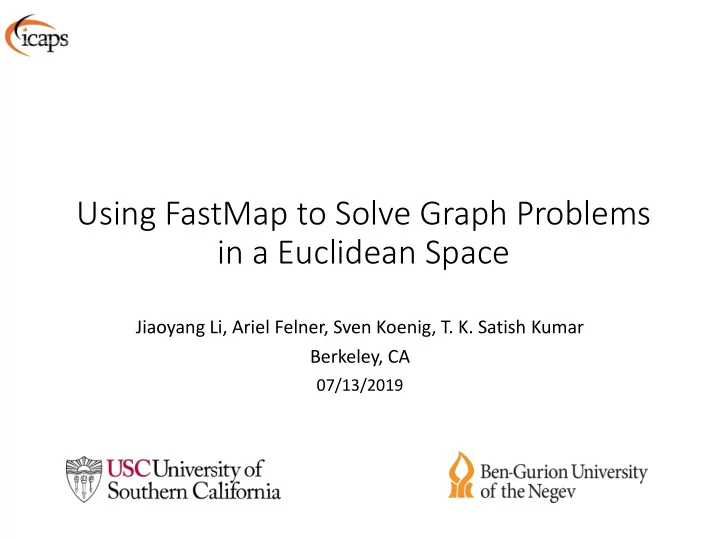

Using FastMap to Solve Graph Problems in a Euclidean Space Jiaoyang Li, Ariel Felner, Sven Koenig, T. K. Satish Kumar Berkeley, CA 07/13/2019
Motivation • Many graph problems have variants that are also studied in a Euclidean space. • Traveling Salesman Problem. • Minimum Spanning Tree. • … • In many cases, the Euclidean variants are easier to solve than the graph variants. 10 y A E 15 20 20 12 B C 6 30 D x
Our idea Euclidean problem Graph problem Graph solution Euclidean solution
Our idea • FastMap [Faloutsos et al., 1995; Cohen et al., 2018] • Every vertex 𝑤 ∈ 𝐻 is mapped to a point 𝑞 ∈ 𝑆 𝐿 . • shortest_path_distance 𝑤 𝑗 , 𝑤 𝑘 ≈ Euclidean_distance 𝑞 𝑗 , 𝑞 𝑘 . • Complexity of the embedding: 𝑃 𝐹 + 𝑊 log 𝑊 . An undirected graph Euclidean embedding
Our idea An undirected graph Euclidean embedding FastMap Pre-processing Graph solution Euclidean problem Euclidean solution Graph problem
Applications 1. Multi-Agent Meeting Problem 2. Path-Finding Problem
Applications 1. Multi-Agent Meeting Problem 2. Path-Finding Problem
Multi-Agent Meeting Problem 𝑙 min 𝑤∈𝑊 distance 𝑡 𝑗 , 𝑤 𝑗=1 Start locations Meeting location
Multi-Agent Meeting Problem
Multi-Agent Meeting Problem Fermat-Weber problem (1-median problem) Start locations
Multi-Agent Meeting Problem Start locations Median point in the Euclidean space
Multi-Agent Meeting Problem Start locations Meeting location Median point in the Euclidean space
Experiments 10 start locations Suboptimality Dijkstra Graph Runtime (ms) (%) runtime (ms) 0.22 7 8 Game grids 3.00 22 22 6.54 148 177 Maze grids 6.76 268 362 5.96 117 181 Random grids 20.53 275 409 33.81 1 2 General graphs 34.80 4 10 All grids are from [Sturtevant 2012]. General graphs are from [Beasley 1990].
Experiments 100 start locations Suboptimality Dijkstra Graph Runtime (ms) (%) runtime (ms) 0.22 7 58 Game grids 1.32 22 187 4.83 149 1,730 Maze grids 3.95 268 3,535 2.99 118 1,744 Random grids 17.81 275 4,051 12.53 2 16 General graphs 16.79 4 90 All grids are from [Sturtevant 2012]. General graphs are from [Beasley 1990].
Experiments 1000 start locations Suboptimality Dijkstra Graph Runtime (ms) (%) runtime (ms) 0.07 11 510 Game grids 0.98 27 1,841 2.64 155 17,221 Maze grids 1.17 274 35,450 2.69 124 17,633 Random grids 17.40 280 40,582 9.12 4 144 General graphs 15.57 7 810 All grids are from [Sturtevant 2012]. General graphs are from [Beasley 1990].
Applications 1. Multi-Agent Meeting Problem 2. Path-Finding Problem
Path-Finding Problem
Path-Finding Problem
Path-Finding Problem Start and goal locations
Path-Finding Problem Recursion depth r = 1 Middle point in the Euclidean space Start and goal locations
Path-Finding Problem Recursion depth r = 1 Start and goal locations
Path-Finding Problem Recursion depth r = 2 Middle point in the Euclidean space Start and goal locations
Path-Finding Problem Recursion depth r = 2 Start and goal locations
Path-Finding Problem
Experiments • The runtime is worse than A* search. 7500 r=0 6000 A* nodes 4500 r=1 3000 r=2 1500 r=3 r=4 r=5 r=6 0 260 280 300 320 340 Solution cost r is the recursion depth. r = 0 reduces to A* search.
Summary • Many graph problems have Euclidean variants that are easier to solve. • Our framework: Graph problem Euclidean solution Euclidean problem Graph solution • Two applications: • The multi-agent meeting problem. • The path-finding problem.
Recommend
More recommend